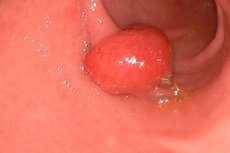Medical expert of the article
New publications
Consequences and complications of endometrial polyp
Last reviewed: 08.07.2025

All iLive content is medically reviewed or fact checked to ensure as much factual accuracy as possible.
We have strict sourcing guidelines and only link to reputable media sites, academic research institutions and, whenever possible, medically peer reviewed studies. Note that the numbers in parentheses ([1], [2], etc.) are clickable links to these studies.
If you feel that any of our content is inaccurate, out-of-date, or otherwise questionable, please select it and press Ctrl + Enter.

Despite the fact that in many cases, locally limited proliferation of cells of the uterine mucosa in the form of a polyp is detected by chance and is considered a benign formation, the consequences and complications of an endometrial polyp can be quite serious.
How fast does an endometrial polyp grow?
As gynecologists note, no woman is immune from the formation of a polyp in the uterus, since the main feature of the mucous membrane lining this organ is the ability of its cells to renew themselves after being rejected during each menstruation, supported by the corresponding hormones and enzymes. And an endometrial polyp grows if there is some kind of failure in this natural process, most often hormonal.
How fast does an endometrial polyp grow? Endometrial polyps – depending on their morphology – can be functional (formed from epithelial, glandular and stromal cells of the functional layer of the mucous membrane) and basal (growing from a deeper layer).
The functional layer is completely lost during menstruation and, under the influence of estrogen, grows intensively in the first half of the menstrual cycle (during the proliferative or follicular phase). With hyperactive cell proliferation, polyps in it grow faster than in the underlying basal layer (the cells of which are the basis for the regeneration of the functional layer). The speed at which this process occurs is unknown, but the lower the intensity of polyp growth, the more obvious the benign nature of the formation.
Why is endometrial polyp dangerous?
Although the presence of an endometrial polyp is asymptomatic in most cases, its negative consequences can manifest themselves in the fact that:
- menstruation is very heavy and lasts longer than usual;
- spontaneous bleeding occurs between menstrual periods, which often leads to a significant decrease in the level of hemoglobin in the blood and anemia;
- aching or cramping pains occur in the lower abdominal cavity due to contractions of the uterine muscles;
- endometrial polyp often bleeds after intercourse;
- there may be various types of vaginal discharge, indicating the presence of an infection;
- Uterine bleeding is possible in women during the early postmenopausal period (especially when taking estrogen drugs).
Women of childbearing age often experience infertility with endometrial polyps, particularly with significant sizes of the formation or its localization near the fallopian tubes. In this case, the frequency of ectopic pregnancies increases, and the onset of uterine pregnancy is at risk of spontaneous termination.
As clinical experience shows, the main condition for restoring a woman’s fertility is the removal of the pathologically overgrown mucous membrane from the uterine wall, and then a normal pregnancy after an endometrial polyp becomes possible.
But the most dangerous complication of an adenomatous polyp of the uterine mucosa is its malignancy, that is, its transformation into a malignant formation. How often do endometrial polyps degenerate? According to statistics, endometrial polyps become malignant in less than 1% of cases. At the same time, as histological studies show, approximately 0.5% of endometrial polyps contain atypical glandular cells characteristic of adenocarcinoma.
Can an endometrial polyp resolve?
A solitary endometrial polyp that has arisen in its functional layer may resolve on its own during pregnancy, and then, when performing an ultrasound of the uterus some time after childbirth, it is visually determined that the endometrial polyp has disappeared.
Can an endometrial polyp come out on its own? Yes, if the polyp is glandular and has a thin stalk, this is possible. There are frequent cases when women notice that a small endometrial polyp came out with their period.
Recurrence of endometrial polyp
The main method of getting rid of polyps is their removal by hysteroscopic polypectomy (hysteroresectoscopy). And although this method is very effective, providing resection of the polyp simultaneously with its stalk, recurrence of endometrial polyps is not considered rare.
According to some data, in almost ten cases out of a hundred, a repeat endometrial polyp forms after removal – in the same place or nearby.


 [
[